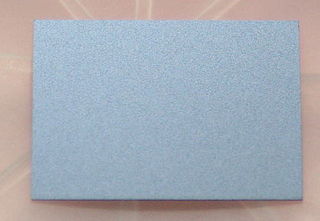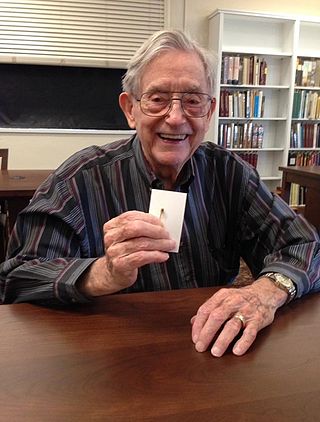
A light-emitting diode (LED) is a semiconductor device that emits light when current flows through it. Electrons in the semiconductor recombine with electron holes, releasing energy in the form of photons. The color of the light is determined by the energy required for electrons to cross the band gap of the semiconductor. White light is obtained by using multiple semiconductors or a layer of light-emitting phosphor on the semiconductor device.

Optoelectronics is the study and application of electronic devices and systems that find, detect and control light, usually considered a sub-field of photonics. In this context, light often includes invisible forms of radiation such as gamma rays, X-rays, ultraviolet and infrared, in addition to visible light. Optoelectronic devices are electrical-to-optical or optical-to-electrical transducers, or instruments that use such devices in their operation.

A laser diode is a semiconductor device similar to a light-emitting diode in which a diode pumped directly with electrical current can create lasing conditions at the diode's junction.

An opto-isolator is an electronic component that transfers electrical signals between two isolated circuits by using light. Opto-isolators prevent high voltages from affecting the system receiving the signal. Commercially available opto-isolators withstand input-to-output voltages up to 10 kV and voltage transients with speeds up to 25 kV/μs.

Indium phosphide (InP) is a binary semiconductor composed of indium and phosphorus. It has a face-centered cubic ("zincblende") crystal structure, identical to that of GaAs and most of the III-V semiconductors.

Shuji Nakamura is a Japanese-American electronic engineer and inventor who created the blue LED, a major breakthrough in lighting technology. Nakamura specializes in the field of semiconductor technology, and he is a professor of materials science at the College of Engineering of the University of California, Santa Barbara (UCSB).
A vertical-external-cavity surface-emitting-laser (VECSEL) is a small semiconductor laser similar to a vertical-cavity surface-emitting laser (VCSEL). VECSELs are used primarily as near infrared devices in laser cooling and spectroscopy, but have also been explored for applications such as telecommunications.
OSRAM Licht AG is a German company that makes electric lights, headquartered in Munich and Premstätten (Austria). OSRAM positions itself as a high-tech photonics company that is increasingly focusing on sensor technology, visualization and treatment by light. The company serves customers in the consumer, automotive, healthcare and industrial technology sectors. The operating company of OSRAM is OSRAM GmbH.

A laser pointer or laser pen is a small handheld device with a power source and a laser diode emitting a very narrow coherent low-powered laser beam of visible light, intended to be used to highlight something of interest by illuminating it with a small bright spot of colored light.

A blue laser emits electromagnetic radiation with a wavelength between 400 and 500 nanometers, which the human eye sees in the visible spectrum as blue or violet.
ams-OSRAM AG, formerly known as austriamicrosystems AG and ams AG, is an Austrian electronics company that designs and manufactures sensors for small form factor, low power, highest sensitivity and multi-sensor applications. Products include sensors, sensor ICs, interfaces and related software for mobile, consumer, communications, industrial, medical, and automotive markets.
Aluminium gallium indium phosphide is a semiconductor material that provides a platform for the development of multi-junction photovoltaics and optoelectronic devices. It spans a direct bandgap ranging from ultraviolet to infrared photon energies.
The Fraunhofer Institute for Applied Optics and Precision Engineering (IOF), also referred to as the Fraunhofer IOF, is an institute of the Fraunhofer Society for the Advancement of Applied Research (FHG). The institute is based in Jena. Its activities are attributed to applied research and development in the branch of natural sciences in the field of optics and precision engineering. The institute was founded in 1992.
Nichia Corporation is a Japanese chemical engineering and manufacturing company headquartered in Anan, Japan with global subsidiaries. It specializes in the manufacturing and distribution of phosphors, including light-emitting diodes (LEDs), laser diodes, battery materials, and calcium chloride.
The European Photonics Industry Consortium (EPIC) is a not-for-profit association with headquarters in Paris, France. EPIC serves the photonics community through a regular series of workshops, market studies and partnering. EPIC focuses its actions on LEDs and OLEDs for lighting, optical fiber telecommunications, laser manufacturing, sensors, photovoltaics and photonics for life sciences. EPIC coordinates its activities internationally through its membership in the International Optoelectronics Association.

The Ferdinand-Braun-Institut, Leibniz-Institut für Höchstfrequenztechnik (FBH) is a research institute, which is a member of the Gottfried Wilhelm Leibniz Scientific Community. The institute is located in Berlin at the Wissenschafts- und Wirtschaftsstandort Adlershof (WISTA), its research activity is applied science in the fields of III-V electronics, photonics, integrated quantum technology and III-V technology

James Robert Biard was an American electrical engineer and inventor who held 73 U.S. patents. Some of his more significant patents include the first infrared light-emitting diode (LED), the optical isolator, Schottky clamped logic circuits, silicon Metal Oxide Semiconductor Read Only Memory, a low bulk leakage current avalanche photodetector, and fiber-optic data links. In 1980, Biard became a member of the staff of Texas A&M University as an Adjunct Professor of Electrical Engineering. In 1991, he was elected as a member into the National Academy of Engineering for contributions to semiconductor light-emitting diodes and lasers, Schotky-clamped logic, and read-only memories.

MicroLED, also known as micro-LED, mLED or μLED is an emerging flat-panel display technology consisting of arrays of microscopic LEDs forming the individual pixel elements. Inorganic semiconductor microLED (μLED) technology was first invented in 2000 by the research group of Hongxing Jiang and Jingyu Lin of Texas Tech University while they were at Kansas State University. The first high-resolution and video-capable InGaN microLED microdisplay in VGA format was realized in 2009 by Hongxing Jiang and Jingyu Lin and their colleagues at Texas Tech University and III-N Technology, Inc. via active driving of microLED array by a complementary metal-oxide semiconductor (CMOS) IC. Compared to widespread LCD technology, microLED displays offer better contrast, response times, and energy efficiency. They are also capable of high speed modulation, and have been proposed for chip-to-chip interconnect applications.
Light-emitting diodes (LEDs) produce light by the recombination of electrons and electron holes in a semiconductor, a process called "electroluminescence". The wavelength of the light produced depends on the energy band gap of the semiconductors used. Since these materials have a high index of refraction, design features of the devices such as special optical coatings and die shape are required to efficiently emit light. A LED is a long-lived light source, but certain mechanisms can cause slow loss of efficiency of the device or sudden failure. The wavelength of the light emitted is a function of the band gap of the semiconductor material used; materials such as gallium arsenide, and others, with various trace doping elements, are used to produce different colors of light. Another type of LED uses a quantum dot which can have its properties and wavelength adjusted by its size. Light-emitting diodes are widely used in indicator and display functions, and white LEDs are displacing other technologies for general illumination purposes.










